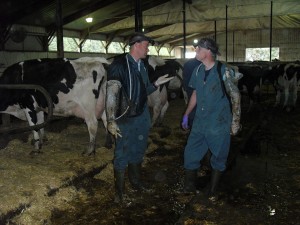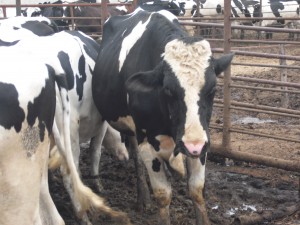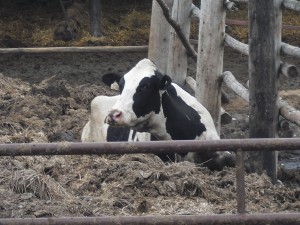It’s 7:42 a.m. Tuesday morning. You slept through your alarm, half way to work you realize you forgot your coffee on the kitchen table, and by looking in the rear view window you see that your hair is a mess. At 8:07 a.m. you arrive at work seven minutes late. A bad start to the day, and at some point we have all had at least one or two, or so we think.
Let’s start again but this time as a cow. It’s 7:42 a.m. Tuesday morning. You’ve just barely lied down after being milked, you haven’t had a chance to taste the fresh silage in front of you yet, the vet spots your ear tag and it matches the number on the list. At 8:07 a.m. with your head in the head-gate you consider urinating, but no need the vet has already done that for by putting pressure on your bladder while he rectally palpates during your pregnancy check. Congratulations, your 28 days in and eight more months to go.
- A vet checking a “fresh” cow for a uterine infection after recently calving.
Herd health is a fundamental aspect in maximizing production in any dairy operation and requires cooperation between the farmer and the farm veterinarian. The role and the procedures used by the veterinarian in large animal practice has transformed as animal agriculture has advanced overtime. It’s not just about treating sick cows anymore. In fact, the vet rarely does the on-farm treatments. Giving daily needles, pills, wrapping legs, or drenching cows is all done by the farmer.
So what does the vet do then? On a dairy farm, knowing who is pregnant, who can be bred, knowing who is where in their 21-day cycle, and knowing who is cystic (meaning they have a cyst on one or both of their ovaries) is very valuable information in ensuring the reproductive side of things is running smoothly. The vets are also critical in giving input when making management decisions, coming up with many preventative measures, and of course surgical procedures like a cesarean section for example.
“Preg checks” are a large part of what is included in the biweekly herd health. The vets at Van Ryssel Dairy use portable ultra-sound backpacks for preg checking. The image forms on the pair of glasses they wear over their eyes. It is possible to successfully preg check this way at 28 days as opposed to the standard method of rectal palpation where the animal can be successfully preg checked at 45 days. As you can see, the ultra-sound method can tell you about half a month earlier who needs to be bred again by artificial insemination, which is extremely advantageous. There is one bull kept on farm, Alex, who is the clean-up bull used to ensure those cows not able to be bred by artificial insemination are pregnant by natural means.
- EIi, the kitten and her mom.








Speak Your Mind